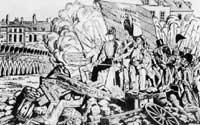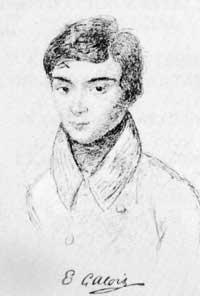Évariste Galois
Political situation
The French Revolution took place between 1789 and 1795. In 1796 he appeared on the scene in Napoleon as head of the Italian army. In 1799 Napoleon left Egypt and struck a coup. Since then he began to conquer Europe. In 1814 the Napoleonic era ended.
It was murky times when the Napoleonic hegemony ended and the Bourbon dynasty was restored. Between 1814-24 Louis XVIII was king and between 1824-30 Charles X, both bourbons. But in 1830 the people rose up and by agreement between the feudals and the bourgeoisie was named king Louis Philip I, of the house Orleans.
Évariste Galois lived in this political environment.
Situation of Mathematics
XIX. At the beginning of the 20th century, mathematics is a broad set of knowledge distributed in apparently different areas: arithmetic and numerical theory; elementary, analytical and descriptive geometry; algebra and infinitesimal calculus. In arithmetic they moved into the world of intangible rules. Numerical theory was a collection of particular problems in which generalization caused great complications.
The study of geometry was based on the geometry of the Greeks, but the influence of the use of analytical methods (coordinates, infinitesimal, etc.) was evident. The main problem of algebra is in the resolution of algebraic equations, that is, in overcoming existing obstacles for the resolution of equations of five or more degrees. The infinitesimal calculation still had weak and debatable bases. It can be said that XIX. World dependence and the “maiden of natural science” characterize early 20th century mathematics. XIX. Throughout the 20th century mathematics would have acquired its freedom and independence.
During the revolution, the work of Lagrange Mècanique analytique (1788) and Fonctions analytiques (1797), Monger Feuilles d´analyse (1795), Laplace Système du monde (1796) and Legendre Eléments de géometrie (1794) appeared. In 1797 they founded Ecole Polytechnique.

In the Napoleonic era, Lacroixen Traité de> Différentiel et Intégral (1797-1800), Carnoten Mètaphysique du> (1797) and Géométrie de position (1803), Series de Fourie (1822), ... and outside France, Metisbolis (1817). In 1813 they founded the Analytical Society in Cambridge.
In the following years, Cours d´Analyse (1821) and Cauchy Waste Calculation (1827), elliptical functions of Abel and Jacobi (1827). And outside France, general discussions on Gauss's Curved Surfaces (1827), Lobatxewsky's geometry (1829), Dirichlet's Functional Theory (1829), among others.
The work of Évariste Galois
In Collège Louis-le-Grand, A.M. The text of "Eléments de géométrie" by Legendre came into his hands. It was then that the hobby of mathematics began. Among others, J.L. Lagrange, and C.F. He read works of Gauss. International He also knew the results of the endorsements.
At the end of his studies at the Collège, he tried to enter the Polytechnic School twice. In the first of them Galois' shortcomings were evident, in the second he refused to answer too simple questions. At the age of 17, Évarista handed Cauchy the paper containing his basic findings to present at the Academy, but Cauchy lost the writing.
In 1830 he entered the General School for his teacher training. There they begin to materialize their basic ideas on solving algebraic equations.
The same year he presented a report to the Academy contest, which did not pass from Cauchy, but Fourier, the secretary, took him home and shortly died, losing the report.
At the beginning of 1831 he wrote and presented at the Academy the work entitled “Conditions of resolubility by roots of equations”. In March he sent a letter to the president of the Academy concerned about his report. In October the answer was reached:
“neither clear enough nor complete enough, ... to be able to resolve its conclusions... that is why we must wait for the author to publish the full version of his work before having his final opinion”.
In his answer he could read:
"I swear, except by the notable men of State and Science..."
"I owe the superiors of the State to write all this in prison, in the seat that does not correspond to reflection... But I have to inform the gentlemen of the Academy that the manuscripts are often lost, even though I cannot understand how they can be so intelligent, that they already carry in their consciousness the death of Abel."
And below:
"That is why I have good reason to believe that the scientific world is going to dismiss my work... with a pious laugh; the most beloved put my guilt on my face; they will compare me with those tireless men who in their day find the picture of the circle every year. In particular, I am going to highlight the laughter of the Polytechnic School examiners who want to monopolize the edition of mathematical treatises and will bend their eyebrows because a young man who has twice suspended not a book, but has had a pride in writing a report."

And below:
"that competitive struggle, that is, selfishness, is not exhausted in Science" and "men will gather together to investigate together".
On the eve of the duel he wrote to his friend Auguste Chevalie his scientific testament, which summarized the main results of Évariste. At the end of the letter he said:
“Address Jacobi and Gauss to give public judgment, not on the truth, but on the importance of this theorem.”
Galois adapted to each algebraic equation a group of permutations in which the properties of the equation were reflected. In particular, it related root resolubility to normal subgroups. This approach is what we know today as Galois theory. The use of the word “team” is also due to Galois. J. 1846 Liouville published the most important mathematical works of Galois.
Recalling professors expelled from the University of the Basque Country.
The life of Évariste Galois
- 1811 Évariste Galois was born on October 11 in Bourg-la-Reine.
- 1823 He passed the entrance exam to the Collège Louis-le-Grand and entered the 4th course.
- 1827 Galois S.L. He read the Treatise of Legend and became interested in mathematics.
- 1828 Failed in the first attempt to enter the Polytechnic School for not systematically preparing.
- 1829 Galois published his first mathematical work. His father committed suicide. After completing his studies at Collège he failed for the second time to enter the Polytechnic School.
- 1830 Admission to the General School. He published three reports. In July he participated in the Parisian revolution with the Republicans, so he was expelled from the Normal School. He entered the National Guard.
- 1831 Galois teaches algebra courses and presents an important writing at the Academy. On May 9 he ran into Luis Felipe, the next day he was imprisoned. On 15 June he was released. On 14 July he was detained by the secret police. In October he wrote two mathematical works at the Sainte-Pélagie prison. At the end of October he was sentenced to six months in prison.
- 1832 Galois was released in April. On May 29 he was challenged to grief. At night he wrote his scientific testament. Galois was seriously injured in the duel on 30 and died on 31, at age 20.
Buletina
Bidali zure helbide elektronikoa eta jaso asteroko buletina zure sarrera-ontzian











